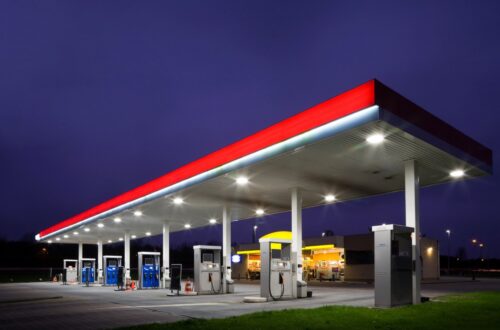Convenience stores, often synonymous with gas stations, have undergone a significant transformation over the past few decades. What was once a simple stop for gasoline and basic necessities has evolved into a multifaceted retail hub catering to a diverse range of consumer needs. This evolution reflects broader shifts in consumer behavior, technological advancements, and competitive pressures. In this article, Nick Kambitsis will explore the journey of convenience stores from their origins in gasoline sales to their current role as full-service retail hubs.
The Origins: Gasoline and Basic Necessities
Convenience stores, as we know them today, began to take shape in the mid-20th century. Initially, these establishments were primarily focused on selling gasoline. The rise of the automobile culture in the post-World War II era fueled the demand for accessible fuel stations. To attract more customers, many gas stations began offering a limited selection of convenience items—soda, cigarettes, snacks, and other basic necessities. These early stores were often small, with a narrow focus on providing quick and essential goods to travelers.
The Shift Toward Expanded Offerings
As consumer expectations grew, convenience stores began to expand their product offerings. By the 1970s and 1980s, many stores had diversified beyond basic items to include a wider range of products such as groceries, household items, and even prepared foods. This expansion was driven by several factors, including increased competition from supermarkets and the growing trend of one-stop shopping, where consumers preferred to buy all their needs in one location.
During this period, the concept of the convenience store began to solidify. These stores were no longer just a place to fuel up but also a destination for everyday shopping. This shift was further supported by the extended operating hours, with many stores staying open late or operating 24/7, catering to the needs of busy consumers.
The Convenience Store as a Retail Hub
The 1990s and early 2000s marked a turning point in the evolution of convenience stores. With the rise of big-box retailers and online shopping, traditional convenience stores faced significant competition. To stay relevant, they had to adapt by offering more diverse and higher-quality products. This period saw the introduction of fresh food options, such as sandwiches, salads, and even sushi, as well as an expanded selection of beverages, including specialty coffees and smoothies.
In addition to the enhanced food and beverage offerings, convenience stores began to incorporate services that catered to the needs of modern consumers. This included ATMs, bill payment services, and even basic banking services in partnership with financial institutions. Some stores also added seating areas, allowing customers to enjoy their meals on-site, further blurring the lines between convenience stores and quick-service restaurants.
The Role of Technology
Technology has played a critical role in the continued evolution of convenience stores. The adoption of point-of-sale (POS) systems, inventory management software, and customer loyalty programs has enabled stores to operate more efficiently and offer a more personalized shopping experience. Mobile apps and online ordering have also become increasingly popular, allowing customers to pre-order items for quick pickup or delivery.
The introduction of self-checkout kiosks and contactless payment options has further streamlined the shopping experience, making it faster and more convenient for customers. These technological advancements have not only improved operational efficiency but also enhanced the overall customer experience, making convenience stores a preferred choice for many.
The Emergence of Full-Service Retail Hubs
Today, convenience stores are more than just a place to pick up a snack or fill up the gas tank—they are full-service retail hubs that cater to a wide range of consumer needs. Many stores now offer a variety of services, including postal services, car washes, lottery ticket sales, and even pharmacy services. Some have partnered with well-known brands to offer premium products, such as gourmet coffee or organic snacks, appealing to a more discerning customer base.
In urban areas, convenience stores have also adapted to serve as micro grocery stores, offering a selection of fresh produce, dairy, and other grocery items. This shift reflects the growing trend of urbanization and the need for accessible, everyday shopping options in densely populated areas. The expansion of convenience store offerings has also extended into the digital realm. Many stores now have a strong online presence, offering delivery services through partnerships with companies like DoorDash and Uber Eats. This has allowed convenience stores to reach a broader audience and compete with other online retailers.
The Future of Convenience Stores
As we look to the future, convenience stores will continue to evolve in response to changing consumer demands and technological advancements. The growing focus on health and wellness is likely to drive further expansion of fresh and organic product offerings. Additionally, sustainability will become a key consideration, with more stores adopting eco-friendly practices such as reducing plastic waste, offering reusable packaging, and sourcing products locally.
The integration of advanced technologies, such as artificial intelligence and automation, will also play a significant role in shaping the future of convenience stores. These innovations will enable stores to offer even more personalized experiences, optimize inventory management, and streamline operations. Moreover, the ongoing shift towards electric vehicles (EVs) will have a profound impact on the traditional gasoline sales model. As EV adoption increases, convenience stores may need to adapt by offering charging stations and related services to remain relevant in the transportation sector.
The evolution of convenience stores from gasoline sales to full-service retail hubs is a testament to their ability to adapt and innovate in response to changing consumer needs. What started as a simple stop for fuel and basic items has grown into a dynamic and essential part of the retail landscape. As technology continues to advance and consumer preferences evolve, convenience stores will undoubtedly continue to reinvent themselves, offering new products and services that cater to the demands of modern life. In doing so, they will remain a vital and convenient resource for communities across the globe.
